Solved GATE Questions on Hydraulic Machines
Question 1. Match the following
| P. Curtis |
1. Reaction steam turbine
|
| Q. Rateau | 2. Gas turbine
|
| R. Kaplan | 3. Velocity compounding
|
| S. Francis | 4. Pressure compounding
|
| 5. Impulse water turbine
|
|
| 6. Axial turbine
|
|
| 7. Mixed flow turbine
|
|
| 8. Centrifugal pump
|
(A) P-2, Q-1, R-7, S-6
(B) P-3, Q-1, R-5, S-7
(C) P-1, Q-3, R-1, S-5
(D) P-3, Q-4, R-7, S-6
GATE-ME-2003
Hint 1. (Ans D)
Question 2. A centrifugal pump running at 500 rpm and its maximum efficiency is delivering a head of 30 m at flow rate of 60 litre per minutes. If the rpm is changed to 1000, then the head H in metres and flow rate Qin litresper minute at maximum efficiency are estimated to be
(A) H=60, Q=120
(B) H=120, Q=120
(C) H= 60, Q=4800
(D) H= 120, Q=30
GATE-ME-2003
Hint 2. (Ans B)

Since







Question 3. Match the following
| P-Reciprocating pump | 1. Plant with power output below 100 kW |
| Q-Axial flow pump | 2. Plant with power output between 100 kW to 1 MW |
| R-Microhydel plant | 3. Positive displacement |
| S-Backward curved vanes | 4. Draft tube |
| 5. High flow rate, low pressure ratio | |
| 6. Centrifugal pump impeller |
(A)v P-3, Q-5, R-6, S-2
(B) P-3, Q-5, R-2, S-6
(C) P-3, Q-5, R-1, S-6
(D) P-4, Q-5, R-1, S-6
GATE-ME-2004
Hint 3. (Ans C)
Question 4. At hydroelectric power site, available head and flow rate are 24.5 m and 10.1  respectively. If the turbine to be installed is required to run at 4.0 revolution per second (rps) with an overall efficiency 90%, then suitable type of turbine for the site is
respectively. If the turbine to be installed is required to run at 4.0 revolution per second (rps) with an overall efficiency 90%, then suitable type of turbine for the site is
(A) Francis
(B) Kaplan
(C) Pelton
(D) Propeller
GATE-ME-2004
Hint 4. (Ans A)
Given : H=24.5 m, Q=10.1 
N=4 rev/s=4 60=240 r.p.m
60=240 r.p.m

 Power generated
Power generated



Again, 
 =205.80
=205.80

Hence turbine is Francis
Question 5. A centrifugal pump is required to pump water to an open water tank situated 4 km away from the location of the pump through a pipe diameter 0.2 m having Darcy friction factor of 0.01. The average speed of water in the pipe is 2 m/s. If it is to maintain a constant head of 5m in the tank, neglecting other minor losses, then absolute discharge pressure at the pump exit is
(A) 0.449 bar
(B) 5.503 bar
(C) 44.911 bar
(D) 55.203 bar
GATE-ME-2004
Hint 5. (Ans B)
Given :


Head loss due to friction,


Pressure corresponding to this head




Question 6. A horizontal shaft centrifugal pump lifts water at 65 . The suction nozzle is one meter below pump centerline. The pressure at this point is equal to 200 kPa gauge and velocityis 3 m/s. Steam tables show saturation pressure at 65
. The suction nozzle is one meter below pump centerline. The pressure at this point is equal to 200 kPa gauge and velocityis 3 m/s. Steam tables show saturation pressure at 65 is 25 kPa, and specific volume of the saturated liquid is 0.0010
is 25 kPa, and specific volume of the saturated liquid is 0.0010  . The pump Net Positive Suction Head (NPSH) in meters is
. The pump Net Positive Suction Head (NPSH) in meters is
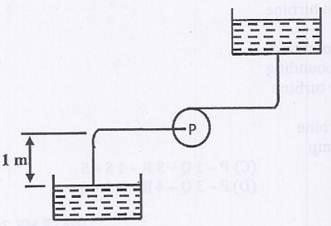
(A) 24
(B) 26
(C) 28
(D) 30
GATE-ME-2006
Hint 6. (Ans A)
Given data
Gauge reading,


Velocity, 
Velocity head at inlet,







NPSH=Pressure at centre line (gauge reading)+Static head  +Velocity Head
+Velocity Head ![]() +
+![]()


Question 7. A large hydraulic turbine is to generate 300 kW at 1000 rpm under a head of 40 m. For initial testing , a 1:4 scale model of the turbine operates under a head of 10 m. The power generated by the model (in KW) will be
(A) 2.34
(B) 4.68
(C) 9.38
(D) 18.75
GATE-ME-2006
Hint 7. (Ans A)
For similar turbines specific power will be same.




Question 8. In a pelton wherel, the bucket peripheral speed is 10 m/s, the water jet velocity is 25 m/s and volumetric flow rate of the jet is 0.1  . If the jet deflection angle is 120
. If the jet deflection angle is 120 and the flow is ideal, the output developed is
and the flow is ideal, the output developed is
(A) 7.5 kW
(B) 15.0 kW
(C) 22.5 kW
(D) 37.5 Kw
GATE-ME-2006
Hint 8. (Ans C)
From velocity triangle,
Power developed=

Question 9. Match the items in column I and Column II
| Column I | Column II |
| P : Centrifugal compressor | 1 : Axial flow |
| Q : Centrifugal pump | 2 : Surging |
| R : Pelton wheel | 3 : Priming |
| S : Kaplan turbine | 4 : Pure impulse |
(A) P-2, Q-3, R-4, S-1
(B) P-2, Q-3, R-1, S-4
(C) P-3, Q-4, R-1, S-2
(D) P-1, Q-2, R-3, S-4
GATE-ME-2007
Hint 9.(Ans A)
Kaplana-Axial flow
Pelton-Impulse type
Question 10. The inlet angle of runner blades of a Francis turbine is 90 . The blades are so shaped that the tangential component of velocity at blade outlet is zero. The flow velocity remains constant throughout the blade passage and is equal to half of the blade velocity at runner inlet. The blade efficiency of the runner is
. The blades are so shaped that the tangential component of velocity at blade outlet is zero. The flow velocity remains constant throughout the blade passage and is equal to half of the blade velocity at runner inlet. The blade efficiency of the runner is
(A) 25 %
(B) 50 %
(C) 80 %
(D) 89 %
GATE-ME-2007
Hint 10. (Ans C)
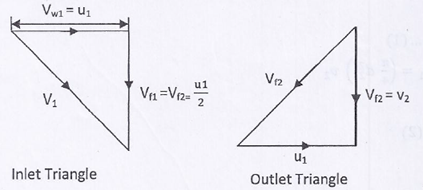
Given,




Blade efficiency



Question 11. Water having a density of 1000  , issues from a nozzle with a velocity of 10 m/s and the jet strikes a bucket mounted on a Pelton wheel. The wheel rotates at 10 rad/s. the mean diameter of the wheel is 1 m. The jet is split into two equal streams by the bucket, such hat each stream is deflected by 120
, issues from a nozzle with a velocity of 10 m/s and the jet strikes a bucket mounted on a Pelton wheel. The wheel rotates at 10 rad/s. the mean diameter of the wheel is 1 m. The jet is split into two equal streams by the bucket, such hat each stream is deflected by 120 , as shown in the figure. Friction in the bucket may be neglected. Magnitude of the torque exerted by the water on the wheel, per unit mass flow rate of the incoming jet, is
, as shown in the figure. Friction in the bucket may be neglected. Magnitude of the torque exerted by the water on the wheel, per unit mass flow rate of the incoming jet, is
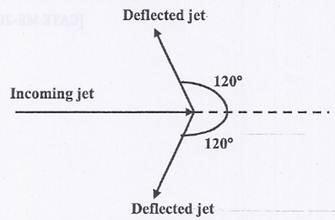
(A) 0 (N.m)/(kg/s)
(B) 1.25 (N.m)/(kg/s)
(C) 2.5 (N.m)/(kg/s
(D) 3.75 (N.m)/(kg/s)
GATE-ME-2008
Hint 11. (Ans D)
Force exerted by the jet of water on the bucket per unit mass flow rate


When v=absolute velocity of jet=10 m/s
u=velocity of plate =
and 
torque/kg/s

Question 12. Consider steady, incompressible and irrotational flow through a reducer in a horizontal pipe where the diameter is reduced from 20 cm to 10 cm. The pressure in the 20 cm pipe just upstream of the reducer is 150 kPa. The fluid has a vapour pressure of 50 kPa and a specific weight of 5  . Neglecting frictional effects, the maximum discharge (
. Neglecting frictional effects, the maximum discharge ( ) that can pass through the reducer without causing cavitation is
) that can pass through the reducer without causing cavitation is
(A) 0.05
(B) 0.16
(C) 0.27
(D) 0.38
GATE-ME-2009
Hint 12. (Ans B)
Considering potential head difference =0

Apply Bernoulli’s theorem

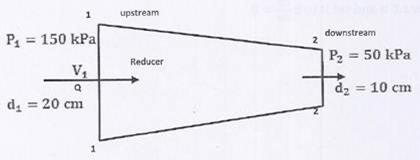





Also, discharge



From equation (1) and (2)





Question 13. A hydraulic turbine develops 1000 kW power for a head of 40m. if the head id reduced to 20 m, the power developed (in kW) is
(A) 177
(B) 354
(C) 500
(D) 707
GATE-ME-2010
Hint 13. (Ans B)




Question 14. The velocity triangles at the inlet and exit of the rotor of a turbomachine are shown. V denotes the absolute velocity of the fluid. W denotes the relative velocity of the fluid and U denotes the blade velocity. Subscripts 1 and 2 refer to the inlet and outlet respectively. If  , the degree of reaction is
, the degree of reaction is
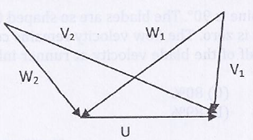
(A) 0
(B) 1
(C) 0.5
(D) 0.25
GATE-ME-2012
Hint 14. (Ans C)
For symmetrical velocity, dBase of reaction is 0.5.
Question 15. In order to have maximum power from a pelton turbine, the bucket speed must be
(A) Equal to jet speed
(B) Equal to half of the jet speed
(C) Equal to twice of the jet speed
(D) Independent of the jet speed
GATE ME-2013
Hint 15. (Ans B)

For power to be maximum



Another way
Just differentiate P w.r.t u and set it to ![]()
1. (D), 2. (B), 3. (C), 4. (A), 5. (B), 6. (A), 7. (A), 8. (C), 9. (A), 10 (C), 11. (D), 12. (B), 13. (B), 14. (C), 15. (B)
One Response to “Previous Years GATE MCQ’s on Hydraulic Machines”
Harsh Joshi
Notify me…. Every day… The solved quations of GATE ME… Thank you..! Content is very good